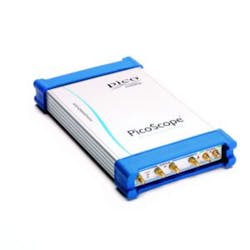Pico Technology has increased the bandwidth of its PicoScope 9300 family of sampling oscilloscopes with two new 25-GHz models. The USB-controlled sampling oscilloscopes are a cost-effective solution to today’s proliferation of gigabit-per-second data streams and their copper, wireless, and optical fiber interconnect, the company said.
For many engineers, the vendor said, owning a real-time scope with 25-GHz bandwidth is unrealistic, with prices starting from $200,000. Renting is usually the only option but even that can cost over $15,000 per month. The new models enable you to have a 25-GHz sampling oscilloscope on your bench every day or where and when you need it, for the equivalent of one month’s rent of a 25-GHz real-time box.
Having chosen your oscilloscope, you will want to probe your multiple broadband signals in-system and with minimal invasion of the measurement, all without interrupting system function. For this you can employ the cost-effective, low-invasive, high-performance PicoConnect 900 probes. Uniquely configured as interchangeable AC or DC coupled probe heads in three division ratios (÷5, ÷10, and ÷20), these are suited to in-system probing of analog, pulse, impulse, and high-speed serial data streams. What’s more, they will interface to any other instrument type with 50-Ω inputs.
All PicoScope 9300 sampling oscilloscopes can now be upgraded, free, to full touchscreen operation with the latest PicoSample 3 software. PicoSample 3.25 also includes new masks for USB 2.0 and USB 3.1 Gen1 and Gen2.
The new PicoScope 9301-25 and 9341-25 sampling sscilloscopes are now available for $16,765 and $26 235, respectively.
PicoScope 9300 Series sampling oscilloscopes
Pico Technology opens APAC office
In related news, Pico Technology announced the opening of its new office in Shanghai, China, to give a local presence for its APAC (Asia-Pacific) sales and support. Managing director Alan Tong said, “Today sees the opening of Pico Technology’s APAC office in Shanghai, China. I am proud that Pico is expanding; this opening will allow us to have a local presence in the APAC region, so we can support our customer base here more closely. We have a unique sales approach where we treat customers as our friends, with free software upgrades and technical support for the lifetime of each product. We will now be able to extend this close relationship with our customers based in the APAC region.”
This expansion also sees the introduction of an APAC team, headed by Sui Li, vice president, Asia-Pacific sales. Sui Li said, “I am excited to be joining this dynamic company with a long-standing presence as a leader in the PC oscilloscopes market. I look forward to expanding Pico’s business in the APAC region and building on the existing strengths of the brand in the area.”
In 2016 Pico Technology celebrated 25 years of business. Pico data loggers, oscilloscopes, and signal generators are used by engineers, scientists and technicians around the globe to bring their products to market. Pico automotive diagnostics products help keep the wheels turning for vehicle manufacturers and service organizations on every continent, the company said.
About the Author

Rick Nelson
Contributing Editor
Rick is currently Contributing Technical Editor. He was Executive Editor for EE in 2011-2018. Previously he served on several publications, including EDN and Vision Systems Design, and has received awards for signed editorials from the American Society of Business Publication Editors. He began as a design engineer at General Electric and Litton Industries and earned a BSEE degree from Penn State.


